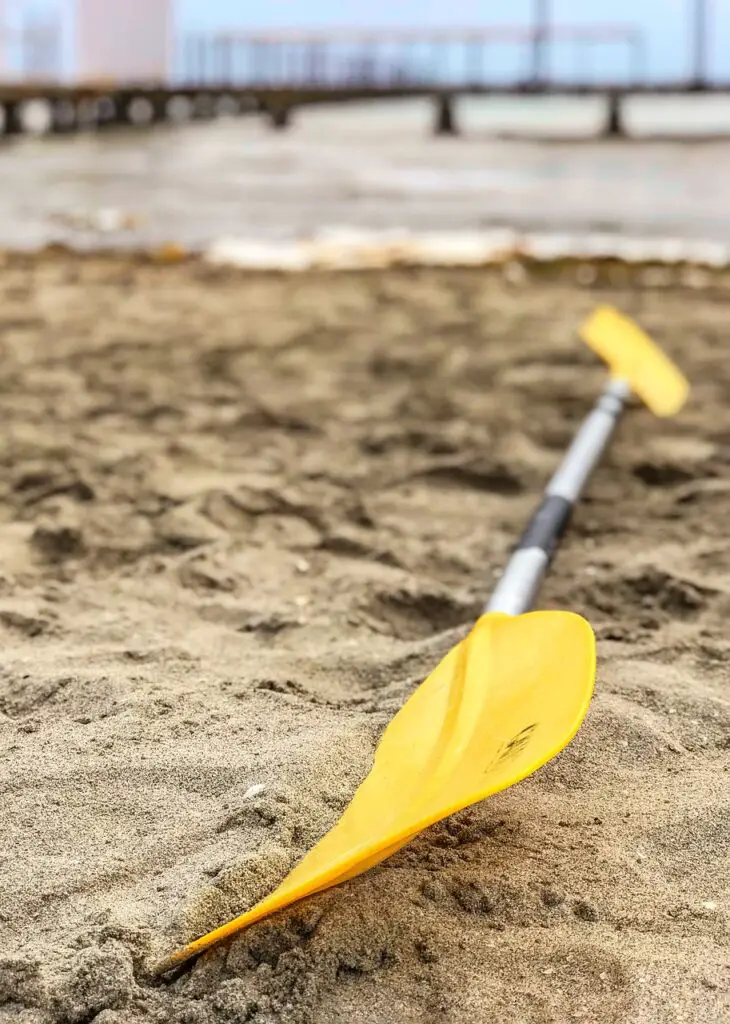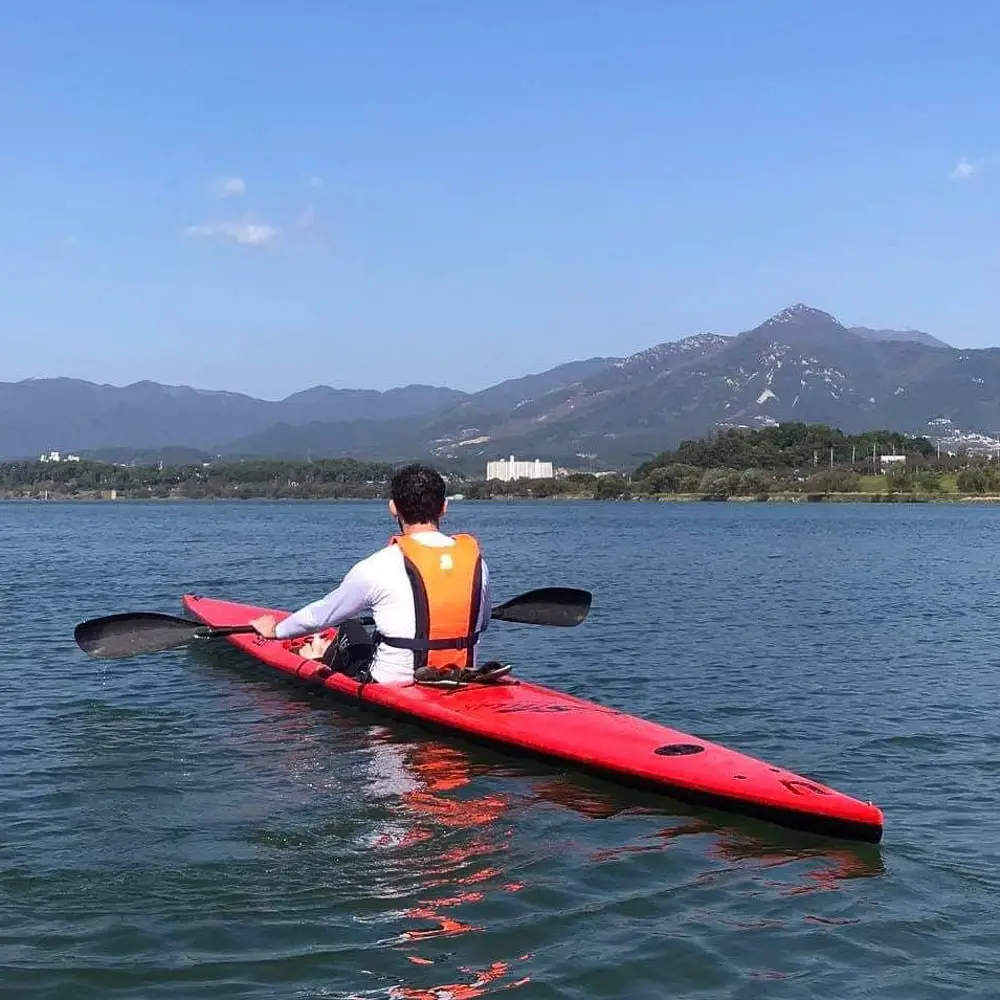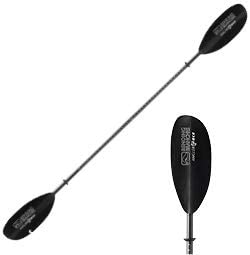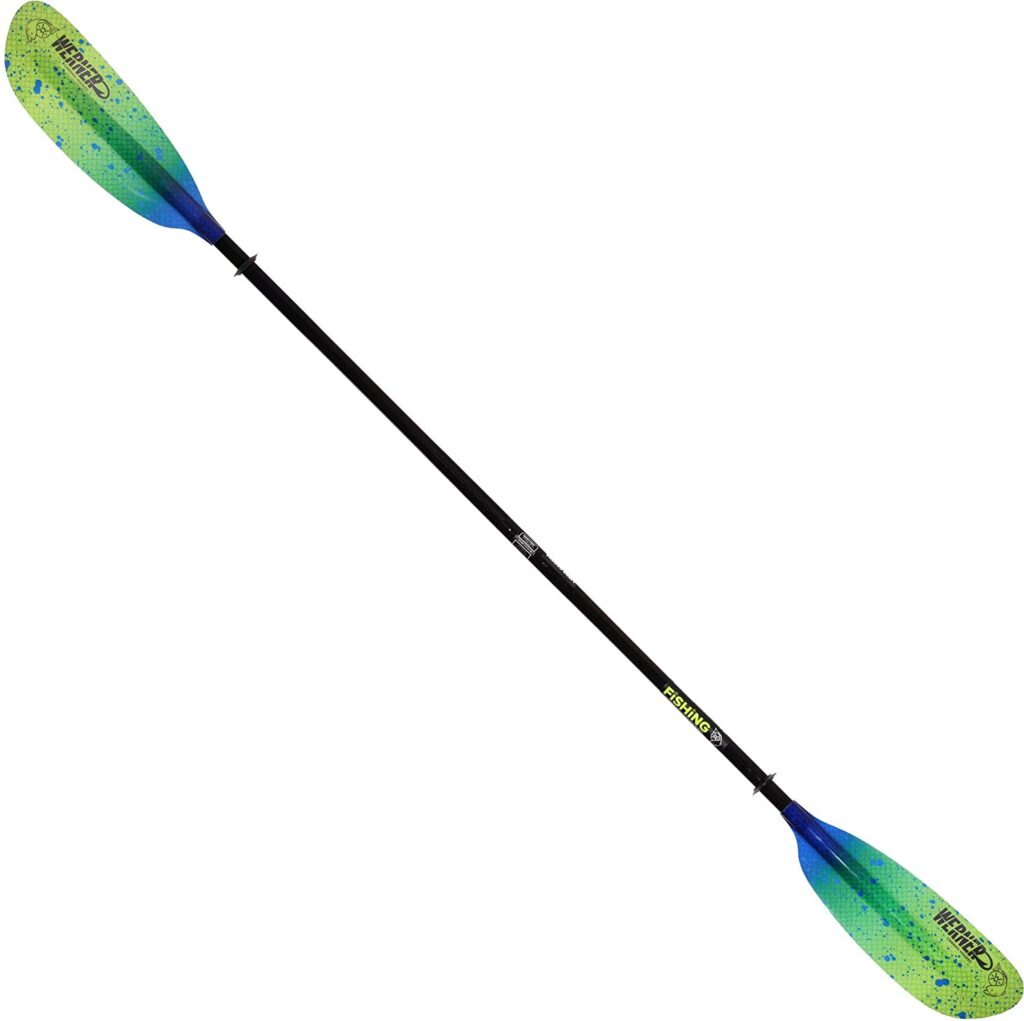Us fishermen can spend days researching and trailing different fishing kayaks hoping to find the perfect one. We then haul our expensive new toy to the local lake and start paddling. More often than not with one of the cheapest, heaviest paddle which was supplied with the Kayak. While fishing in rivers and lake might not be as demanding as heading out to sea, having a quality paddle still makes kayaking easier.
My first paddle was supplied with my Ok Prowler fishing kayak. It was a single piece with plastic blades and an aluminum shaft. It was not long before paddle envy got to me. I wanted a nicer paddle. It is simply less enjoyable splashing away with an inefficient blade. I replaced it with a full carbon paddle, with similar dimensions, but half the weight. The difference was night and day, every stroke was easier, and I could travel further and faster without resting. I eventually lost that paddle and replaced it with another full carbon, which I eventually replaced with a full carbon Braca IV Wing paddle, and I have never looked backed.
Bundled paddles are fine for light use, but. Such as paddling across a pond or floating down a slow flowing river. For longer paddles, they are heavy and with every stroke that weight negatively impacts on efficiency. An average paddler makes approximately 1000 strokes per mile paddle, the extra weight of a heavy paddle does add up.
There is an enormous selection of paddles available, from super budget to premium and everything in between. In most cases, you get what you pay for. Fortunately, much lighter Paddles are not significantly more expensive than budget models. When choosing a paddle, do not blindly trust reviews. There is a sub $40 paddle on a large e-commerce store with over 2000 ratings and a 4.7/5 rating. At a glance, it looks like a bargain. On closer inspection, the shaft is so cheaply constructed that any serious pressure can cause it to bow. You do not want that to happen during a brace stroke.
Types of Kayak paddles
There are three main types of kayak paddles, the traditional euro blade, which is what the vast majority of recreational paddlers use. The wing blade, used by performance paddlers gives a more powerful stroke and really grips onto the water. Finally, the Greenland paddle invented and used by the Inuit population of Greenland for centuries.
All three paddle types have their own strengths and weaknesses.
Euro Blade.

Euro blades are very common, they are readily available across all price brackets, materials, shapes and lengths. Virtually all recreational paddlers including kayak fishermen use euro blades.
Designed for whitewater paddling, the Euro Blade is good for powerful steering and control strokes. All advanced paddle strokes and braces are possible with a euro blade. The blade feels less stable through the water than Greenland or Wing blades.
The major downsides is the large flat blades catch the wind, which is why many paddlers choose to paddle with a 35-45 degree feather to minimize wind.
How to paddle a fishing kayak with a Euro Blade
Low angle strokes are best suited for paddling fishing kayaks. Start by pushing your control hand out no higher than chest height, then rotate your upper body, including shoulder towards the stoke. When fully extended, plant your blade into the water and pull the kayak forward, pass the blade by rotating your torso back. You will want the blade to exit the water just before your hips. Leaving your blade in the water too long just causes drag slowing you down.
Now, in most fishing kayaks, it is next to impossible to paddle with ‘proper’ technique. I certainly can not achieve it, and a mate of mine who used to race at an elite level can,t. The seating position and foot braces in most fishing kayaks, are not set up correctly for full body rotation. Just try your best to work as much body rotation into your stroke rather than just the arms.
High Angle vs Low Angle paddles for fishing kayaks.
Recreational kayakers use two dominant styles of paddling, commonly known as high and low angle. There are paddles designed for both types of stroke. High angle strokes start at above chest height or above. High angle style is useful for speed and power. Useful in short sprints or to avoid an obstacle in Whitewater. Most sea kayakers are predominantly taught to paddle high angle. Paddling above chest height wastes energy. Your body is most powerful at chest height. Try to pick up a heavy object at chin height, chest height, and waist height. Lifting from the chest height is the easiest due the closeness to the most efficient muscles.
High angle strokes catch more wind, and because of the higher center of gravity, the kayak feels less stable. When kayaking, hold the paddle at chest height, which allows the most efficient transfer of power from your core to stroke. Get a euro blade paddle designed for low, or mid angle paddling. That is typically a long thin blade, rather than a wide one. Greenland paddles are suitable for long distance cruising to the fishing spot or for trolling. It takes less energy to keep a kayak moving than it does to paddle in a start and stop fashion.
One exception, if paddling down river, and through rapids, then consider a wider blade like the ones they use for whitewater kayaking. The wide blades allow for more powerful strokes and can turn a kayak faster.
Greenland paddle
Greenland paddles look very different. The blades are very narrow and tapers nearly the entire length of the shaft. The narrow blades allow the paddle to cut through the wind with ease. They are also very quiet through the water, the stealthiest of all paddles. The Inuit designed them for hunting and fishing, so stealth was paramount. Greenland paddles are very good for sneaking up to wary and shy trout. This feature alone makes them one of the best paddles for fresh water fishing.
Greenland paddlers typically paddle at a faster cadence, some consider the narrow blades are much gentler on the body. Average speed is on par with euro paddles, maybe a little slower.
Out of all paddle designs, Greenland paddles are probably the hardest to find retail. Often a work of passions and not mass produced. Most greenland paddles are made from wood or carbon. On average, given the same construction material, Greenland paddles are slightly lighter than euro paddles.
The Inuit originally designed Greenland paddles to paddle 18″-22″ wide kayaks, so much narrower than our fishing kayaks. Nowadays, paddlers of all styles of kayaks have taken up the design. Greenland paddles work fine on wide fishing kayaks.
Wing Paddle

Developed in Sweden in the 1980s, Wing paddles revolutionized kayak racing. Today, kayakers primarily use wing paddles in narrow, fast kayaks, which includes the high performance fishing kayaks out of South Africa. One example is my Stealth Profisha.
They have the most efficient blade design. With proper technique, paddlers can be up to 5% faster for the same effort. One of the biggest differences is that the paddle really grips and holds onto the water, giving reassuring stability while paddling. I taught my wife to paddle with a wing. My wife refuses to use a euro blade, because of the lack of stability in the stroke.
The aerodynamic blade sharp means the wing paddle catches less wind than euro-blades. I paddle mine at 0 feather and have no issues of the blade catching the breeze.
The length of wing paddles often max out at around 225cm, so might not be suitable for ultra wide kayaks. They are also not the best at turning strokes, so if paddling a slow turning kayak without a rudder, then think twice before committing to a wing paddle.
There are many manufacturers of wing paddles. Over the years, I have paddled and recommended in order of increasing-price paddles from Orka , Epic, Jantex and Braca. I could write another entire article on designs of wing paddles, but I feel it is too out of scope for this site. A teardrop design such as the Brača IV or Epic works well. Feel free to contact me for more specific advice.
Paddle Length
Many factors influence the ideal paddle length. Including paddler height, kayak width and paddling style. I use different-length paddles on different kayaks.
The main factor which determines paddle length is the width of the kayak. In my super skinny and tippy racing kayak I use a 214cm wing paddle, on my 60cm Stealth Fishing kayak I extend my wing paddle out to around 218cm. In my wide Ocean Kayak Prowler I use a fixed 223CM euro blade.
Adjustable Length paddles are the best
If budget allows, I strongly advise getting an adjustable-length paddle. They are simply more versatile. It is easier to maintain a high cadence with a shorter paddle, while longer paddles are good for more powerful strokes.
An ‘advanced’ technique only widely known about in long distance kayak racing circles, and still not filtered down into recreational kayaking communities. When paddling gets difficult, either due to battling into a headwind or simply from fatigue, reducing the paddle length makes maintaining the same cadence easier.
Likewise, if feeling fit and strong, then extending the paddle allows for a more powerful stroke and a slight increase in speed. The paddle length is the ‘gear lever’ of the kayak. We all know the difficulty cycling up a steep hill in high gear, likewise do not paddle into a strong headwind with a long paddle.
Any advantages to fixed length paddles?
When I first started paddling, I was a fan of fixed length paddles. That is because cheap split paddles were heavy. A fixed length paddle was lighter and stronger.
But with modern carbon fiber shafts, and durable joiners, there is minimal difference in weight now. So for 99.9% of paddlers, the versatility of a split adjustable length paddle greatly compensates for the slight increase in weight. Split paddles are also easier to store and transport.
Material
Carbon or high-end wooden paddles are the best. Fiberglass is somewhere in the middle, good for a spare paddle or occasional light use. Plastic and aluminum are the worst, and I suggest avoiding them.
I love my carbon paddles; they are a dream to use and paddle with compared to the older, heavier glass and plastic paddles which make up the rest of my collection. Even a fairly nice, top end glass blade weighs significantly heavier.
If budget allows, try to stretch for a carbon shaft and blade, or even just a carbon shaft. Carbon shafts are also much warmer to hold in freezing weather.
Hgh quality wooden paddles are stunning to look at and with a strength and weight ratio comparable to carbon. The most popular wood for paddle construction is probably Western Red Cider. Although, other types of cider and even spruce can make nice blades.
My Recommendations on the best paddles for freshwater fishing.
Best budget paddle for fishing in freshwater.
Not everyone wants to spend a lot of money on a paddle. Despite hours of researching and checking over a dozen budget paddles, I struggle to find any I will recommend. Maybe I have been spoiled from years of kayaking with full carbon paddles. Stick with the supplied paddle until you can afford something nicer. Budget paddles typically have aluminum shafts which are heavy, and when companies try to make the shaft thin or lightweight, the paddle becomes weak. Breakages are common for lightweight aluminum paddles.
There is one budget paddle, which I feel is good enough to consider. It is the Neolife Wonitago Waterman Kayak Paddle. Unlike most paddles in its price class, the Waterman has a fiberglass rather than aluminum shaft. The blades are still Polypropylene. It weighs in at around 35oz.
The feature I most like about the Wonitago Waterman is the fully adjustable shaft. For a $50 paddle, it offers a lot of value. I tried to find additional information about the manufacturer, but other than their claim of making paddles for 10 years, I could find nothing of their origins.
BENDING BRANCHES Angler Ace Plus Telescoping 2-Piece Kayak Fishing Paddle

The Bending Banches Angler Ace plus manages to tick most boxes. The basics, a 100% carbon shaft and carbon-reinforced nylon blades makes for a strong and relatively lightweight paddle (32.5oz / 893g)
The feature I feel best sets the telescoping version of this paddle apart from the competition is the fully adjustable shaft, which allows up to 10cm (4inches) of extra length. Perfect for when changing seat position or to shorten the shaft slightly to make the paddle home easier.
There are also several neat fishing-orientated figures. Such as a measuring guide on the shaft. There is also a ‘hook retrieval’ cut out on one blade. Personally, I consider it a bit of a gimmick but occasionally might come in useful. A full carbon version is also available, weighing in at 27oz (765g) although it is nearly double the price.
Werner Camano: Hooked

Werner paddles might just be the most famous paddle manufacturer in the United States. It comes at little surprise that they make some excellent if somewhat pricey paddle. The Werner Camano hook is not cheap, coming in a little over $300. At times stock is limited. The paddles are manufactured by paddlers in the United States. Not mass-produced in some nameless industrial estate in Asia.
I am a big fan of the Werner Camano: Hooked with an adjustable straight shaft. It is one of the best paddles for freshwater fishing. Depending on the length, it weighs in at only 30oz (851g). Not bad for a paddle that uses fiberglass blades. The long thin blades allows for a very clean and efficient stroke, especially at low intensities. A great option for stealthy paddling to cause the less disturbance to the water as possible. Perfect for sneaking up to a weed bed or in close to overhanging vegetation. I rate is as one of the best paddles to use when targeting shy fish like trout.
The adjustable staff is excellent, allowing up to 20cm (8inches) of range. Perfect if you need to change the length of the paddle to suit different sitting positions, or even to shorten it slightly to make paddling into the current easier.
If you want the absolute lightest weight, the Werner Kalliste offers the same design in full carbon. Weighing it at just 22.5oz (634g) which is impressively light even for carbon.
